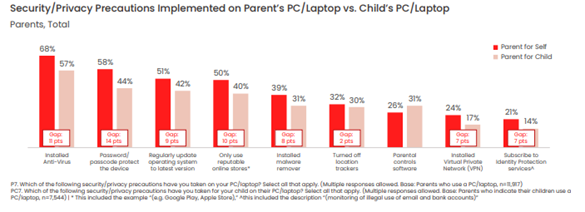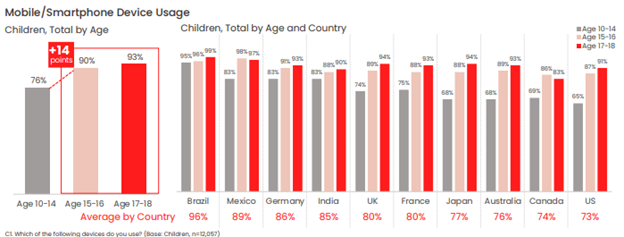“Together for a better internet.” That’s the rallying cry of this year’s Safer Internet Day, and it’s one we’re happy to hear. Particularly from a parent’s perspective.
Safer Internet Day celebrates its 20th year on February 7th and focuses on ways we can all protect, empower, and respect all children when they go online—and gives us an opportunity to reflect on what that really means.
Consider that for some time now, children have found themselves born into an online world. As soon as they can pick up a toy, they can pick up a phone or tablet too. And they often do, given that they’re growing up in homes where one is practically always in reach. With that, their online life begins.
Learning how to live life online is simply another part of growing up nowadays. And that’s where we as parents play a significant role. Just as in every other aspect of life, they look to us for guidance, encouragement, and new things to see and do online. Safely, too.
Children look to their parents and families when it comes to staying safe online.
Children have said as much. In our recent global report entitled “Life Behind the Screens of Parents, Tweens, and Teens,” we asked who is best suited to teach them about being safe online. Children said their parents are the clear winners. Nearly three-quarters of children pointed to parents, almost twice more than teachers at school (39%) and more than twice over for online resources (34%).
However, while parents agreed with this, it appears they didn’t always follow through. For starters, parents reported using basic protection on their own computers at a relatively low rate. Even the simplest of security steps scored relatively low despite how relatively easy they are to take. That included using antivirus software (68%), protecting the computer with a password (58%), or sticking to reputable online stores when shopping (50%). These figures dropped yet lower when asked if they took the same precautions for their children on their computers.
For example, only 57% of parents said they installed antivirus on their child’s computer and only 44% have their child’s password or passcode protect their computer, as illustrated by the drops in the chart below.

This trend extends to smartphones as well. While 56% of parents said that they protect their smartphone with a password or passcode, only 42% said they do the same for their child’s smartphone—a 14% difference. Again, considering how easy it is to create a password or passcode for a phone, and how much of our online lives course through those devices, that figure would ideally come in at 100%.
In all, many parents protect their children even less than they protect themselves.
Children group up quickly online—quicker than you might think
Everyone loves their smartphone. Children particularly so. While parents placed their smartphone as their top device at 59%, followed by their computer or laptop at 42%, tweens and teens put their smartphone at the top of the at a decisive 74%. Second was their gaming console at 68%.
Unsurprisingly, that love for the smartphone pushes children’s internet usage quickly to an adult level at an early age, marking a sort of early mobile maturity where they are exposed to the broader internet full of apps, chats, entertainment, and social media—along with their benefits and risks nearly right away.

Taken with the low level of security measures parents place on their children’s phones, we can see how children are going online with a device that’s largely unprotected—in part because their parents leave their smartphones largely unprotected as well.
Staying safer online takes more than a secure device.
Beyond devices, parents have other concerns about their children as they increasingly spend more time online, particularly as they get older. Some of the top ones include:
Increasingly, staying safe online involve more than protecting devices—it revolves around protecting the people who use them. Topics like the ones above are prime examples. They’re about people, not devices. Further, we have the broader issues of staying more private online and protecting your identity from hackers, scammers, and thieves—where once again, bad actors target people, not their devices.
It’s a lot to keep on top of.
And that can feel a bit overwhelming to a parent. Luckily, as with other aspects of parenting, you don’t have to think about all these topics all at once. They’ll crop up naturally over time, just as the umpteen other teaching moments do over the course of parenting.
Ways we can make a safer internet for our children.
It starts with asking a few questions. What might be on the horizon for our children as they go online over the next few weeks and months? How can you support them? And how can you prepare yourself for that support? Granted, those are some pretty broad questions. Yet we can help:
- Our blog provides a wealth of information on topics that will surely come up, with plenty of articles aimed at parents who want to see their children have a healthy, happy time online.
- Our McAfee Safety Series has several in-depth guides on topics like digital privacy, social media safety, identity protection, and shopping more safely online—all packed with straightforward steps you can take that can make your family safer than before.
As for tools you can use to help keep your children safer online, we just released our McAfee+ Family Plans, online protection that’s personalized for the ones closest to you. Whether you want to protect your partner, children, parents, or a loved one practically anywhere, they offer tailored device, identity, and privacy protection for up to six people.
For your children, that means you can protect them from viruses, sketchy websites, and inappropriate content—plus establish ground rules for screen time, all in a way that’s right for them. Each child also gets their own Protection Score, a reflection of just how safe they are online, which you can quickly review and then get guide you through steps that can make them safer still. In all, it’s a powerful tool for parents who care about their children’s safety online.
“Safer Internet Day: Together for a better internet.”
You have yet another powerful tool at your disposal: conversations. You’ll find that some of the best protection you provide stems from chats with your children.
Sit down with them while they play an online game, ask what apps they like to use, or ask to look when a TikTok reel makes them laugh. These are all-natural moments to get a glimpse into their digital life and simply talk about it—without lectures or preaching. The more you can make talking about life online feel like a normal thing, the more opportunities you’ll get to support them when they need it.
As parents, we can look at our children now and wonder what the internet will bring to them in the next five, ten, or even twenty years from now. It’s exciting, perhaps a bit dizzying, yet it’s more reason to offer your guidance and encouragement, to learn about life online together. That will give them a foundation they can build on, so they can enjoy a fulfilling and safer life online.

